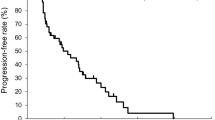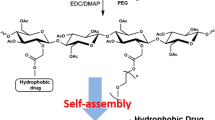Abstract
Zinostatin stimalamer (ZSS) is a new anticancer agent derived from neocarzinostatin (NCS), which is synthesized by conjugation of one molecule of NCS and two molecules of poly(styrene-co-maleic acid). ZSS exhibited potent in vitro and in vivo antitumor activity in preclinical experiments, and a clinical trial of the intra-arterial administration of ZSS with iodized oil on hepatocellular carcinoma showed potent antitumor activity. We investigated the effect of ZSS and NCS on antitumor resistance and found that pretreatment with either drug suppressed the growth of MethA tumors in Balb/c mice and induced tumor eradication when given separately by single administration at therapeutic doses between 1 day and 4 weeks before tumor transplantation. The findings that the cytocidal activity of these drugs was not detected in vivo at the time of tumor transplantation and that tumor regression was preceded by a period of transient growth suggested that tumor regression was due to host-mediated antitumor activity induced by these drugs. Pretreatment with ZSS or NCS also suppressed the growth of Colon 26 carcinoma and Sarcoma 180. The finding that NCS showed the same effect as ZSS suggests that poly(styrene-comaleic acid) is not essential for the induction of hostmediated antitumor activity. Furthermore, apo-ZSS, which lacks cytocidal activity, did not induce antitumor activity. From this, it is suggested that the cytocidal effect of ZSS involves the induction of hostmediated antitumor resistance. In athymic Balb/cnu/nu mice, pretreatment with ZSS or NCS did not induce tumor eradication, suggesting that mature T lymphocytes play an important role in tumor eradication. Challenging MethA was rejected withot transient growth in mice that had been cured of MethA, but challenging Colon 26 was not, showing that anti-MethA resistance was augmented selectively in the MethaA-eradicated mice. Splenocytes from MethA-bearing mice pretreated with the drug showed tumorneutralizing activity beginning 14 days after tumor transplantation. Tumor-neutralizing activity was only induced after MethA transplantation. The effector cells of this tumor-neutralizing activity were Thy1.2+ T lymphocytes that had been passed through a nylonwool column, but no significant augmentation of cell-mediated cytotoxic activity of splenocytes from MethA-eradicated mice was observed in vitro.
Similar content being viewed by others
References
Awwad M, North RJ (1989) Cyclophosphamide-induced immunologically mediated regression of a cyclophosphamide-resistant murine tumor: a consequence of eliminating precursor L3T4+ suppressor T-cells. Cancer Res 49: 1649
Ben-Efraim S, Bocian RC, Mokyr ME, Dray S (1983) Increase in the effectiveness of melphalan therapy with progression of MOPC-315 plasmacytoma tumor growth. Cancer Immunol Immunother 15: 101
Bookman MA, Swerdlow R, Matis LA (1987) Adoptive chemoimmunotherapy of murine leukemia with helper T lymphocyte clones. J Immunol 139: 3166
Carswell EA, Old LJ, Kasel RL, Green S, Fiore N, Williamson B (1975) An endotoxin-induced serum factor that causes necrosis of tumors. Proc Natl Acad Sci USA 72: 3666
Culo F, Klapan I, Kolak T (1993) The influence of cyclophosphamide on antitumor immunity in mice bearing late-stage tumors. Cancer Immunol Immunother 36: 115
Fujita H, Nakayama N, Sawabe T, Kimura K (1970) In vivo distribution and inactivation of neocarzinostatin. Jpn J Antibiot 23: 471
Fujiwara H, Fukuzawa M, Yoshioka T, Nakajima H, Hamaoka T (1984) The role of tumor-specific Lyt-1+2−T cells in eradicating tumor cells in vivo. I. Lyt-1+2−T cells do not necessarily require recruitment of host's cytotoxic T cell precursors for implementation of in vivo immunity. J Immunol 133: 1671
Fuyama S, Komatsu H, Arai S (1991) Effector phenotypes and mechanisms of antitumor immune reactivity of tumor-immunized and tumor-bearing mice in two syngeneic tumors. Cell Immunol 137: 200
Geran RI, Greenberg NH, Macdonald MM, Schumacher AM, Abbott BJ (1972) Protocols for screening chemical agents and natural products against animal tumors and other biological systems. Cancer Chemother Rep 3: 51
Goldberg IH (1987) Free radical mechanisms in neocarzinostatin-induced DNA damage. Free Radical Biol Med 3: 41
Greenberg PD, Kern DE, Cheever MA (1985) Therapy of disseminated murine leukemia with cyclophosphamide and immune Lyt-1+, 2−T cells. Tumor eradication does not require participation of cytotoxic T cells. J Exp Med 161: 1122
Hengst JCD, Mokyr MB, Dray S (1981) Cooperation between cyclophosphamide cytocidal activity and host antitumor immunity in the cure of mice bearing large MOPC-315 tumors. Cancer Res 41: 2163
Honjo K, Suhara Y, Kataoka T (1990) Antitumor activity of host T and non-T cells recovered from tumor nodules after interferon therapy. Jpn J Cancer Res 81: 410
Kataoka T, Matsuura N, Oh-hashi F, Suhara Y (1985) Treatment regimen and host T-cell-dependent therapeutic effect of interferon in mouse solid tumors. Cancer Res 45: 3548
Maeda H (1981) Neocarzinostatin in cancer chemotherapy (review). Anticancer Res 1: 175
Maeda H, Takeshita J, Kanamaru R (1979) A lipophilic derivative of neocarzinostatin. A polymer conjugation of an antitumor protein antibiotic. Int J Peptide Protein Res 14: 81
Maeda H, Matsumoto T, Konno T, Iwai K, Ueda M (1984) Tailor-making of protein drugs by polymer conjugation for tumor targeting: a brief review on SMANCS. J Protein Chem 3: 181
Maeda H, Ueda M, Morinaga T, Matsumoto T (1985) Conjugation of poly(styrene-co-maleic acid) derivatives to the antitumor protein neocarzinostatin. J Med Chem 28: 455
Masuda E, Takemoto T, Tatsuno T, Obara T (1982) Immunosuppressive effect of a trichothecene mycotoxin, Fusarenon-X in mice. Immunology 45: 743
Michael R, Mokyr MB (1993) Characterization of the exogenous interleukin-2 requirements for the generation of enhanced antitumor cytotoxicity by thymocytes from low-dose melphalan-treated MOPC-315 tumor bearers. Cancer Immunol Immunother 36: 37
Mizushima Y, Sendo F, Miyake T, Kobayashi H (1981) Augmentation of specific cell-mediated immune responses to tumor cells in tumor-bearing rats pretreated with the antileukemia drug busulfan. J Natl Cancer Inst 66: 659
Mokyr MB, Barker E, Weiskirch LM, Yakesue BY, Pyle JM (1989) Importance of Lyt2+T-cells in the curative effectiveness of a low dose of melphalan for mice bearing a large MOPC-315 tumor. Cancer Res 49: 4597
Morikawa K, Hosokawa M, Hamada J, Sugawara M, Kobayashi H (1985) Host-mediated therapeutic effects produced by appropriately timed administration of bleomycin on a rat fibrosarcoma. Cancer Res 45: 1502
Morikawa K, Hosokawa M, Hamada J (1986) Possible participation of cytocidal macrophages in the therapeutic effect of bleomycin on a transplantable rat fibrosarcoma. Cancer Res 46: 684
Naruo K, Hinuma S, Shiho O, Houkan T, Ootsu K, Tsukamoto K (1989) Detection and characterization of anti-tumor effector cells in Meth-A-bearing mice treated with recombinant human interleukin 2. Clin Exp Immunol 76: 278
Numasaki Y, Takahashi K, Masuda E, Nohara C, Maeda H (1991) Antitumor effects of a new antitumor agent, zinostatin stimalamer (YM881)—effects on experimental tumors in vitro and in vivo. Jpn J Cancer Chemother 18: 2289
Ray PK, Raychaudhuri S (1981) Low-dose cyclophosphamide inhibition of transplantable fibrosarcoma growth by augmentation of the host immune response. J Natl Cancer Inst 67: 1341
Sendo F, Miyake T, Fuyama S, Arai S (1978) Spontaneous regression of syngeneic transplanted tumor in rats pretreated with the antileukemia drug busulfan. J Natl Cancer Inst 60: 385
Shoval S, Ophir R, Ben-Efraim S (1989) Deficiency in immunocompetence of mice cured from large MOPC-315 plasmacytomas by melphalan therapy. Cancer Immunol Immunother 29: 279
Suzuki F, Munakata T, Maeda H (1988) Interferon induction by SMANCS: a polymer-conjugated derivative of neocarzinostatin. Anticancer Res 8: 97
Takeshita J, Maeda H, Kanamaru R (1982) In vitro mode of action, pharmacokinetics, and organ specificity of poly(maleic acid-styrene)-conjugated neocarzinostatin, SMANCS. Gann 73: 278
Tanaka S, Numasaki Y, Maeda H (1991) Action mechanisms of zinostatin stimalamer (YM881). Jpn J Cancer Chemother 18: 2295
Winn H (1961) Immune mechanisms in homotransplantation. II. Quantitative assay of the immunologic activity of lymphoid cells stimulated by tumor homografts. J Immunol 86: 228
Xu Z, Hosokawa M, Morikawa K, Hatakeyama M, Kobayashi H (1988) Overcoming suppression of antitumor immune reactivity in tumor-bearing rats by treatment with bleomycin. Cancer Res 48: 6658
Author information
Authors and Affiliations
Rights and permissions
About this article
Cite this article
Masuda, E., Maeda, H. Antitumor resistance induced by zinostatin stimalamer (ZSS), a polymer-conjugated neocarzinostatin (NCS) derivative. Cancer Immunol Immunother 40, 329–338 (1995). https://doi.org/10.1007/BF01519634
Received:
Accepted:
Issue Date:
DOI: https://doi.org/10.1007/BF01519634




